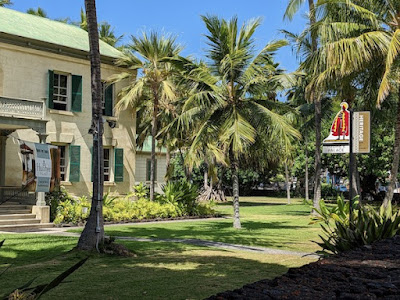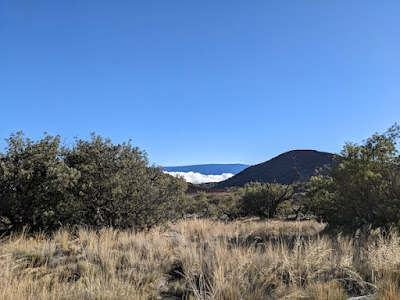Polulu valley was our next stop, and we drove past Hawi and Kohala (birthplace of Kamehameha I) to get there. Even from the parking area it was stunning.
But the plan was to hike down to the valley and back up. A guy stopped us before we started the trail and made sure we were aware that we could die hiking or by drowning in the water. As you can see from this sign, there are more reminders as you descend. I was worried at the very top about slipping down because the path was dry but it was fine once we got going. Certainly better going down first than up, we agreed.
You can see some of the valley at left as Lisa leads the way.
And what a stunning valley it is. Once you get down, you can go right to the valley and the water that snakes out of there, and we saw grazing cattle (I think they were cows) in the distance. But mostly you go left to the water.
For sure this had to be a sculpture left behind. Lisa hiked out over the rocks further while I stayed on driftwood logs and hung out, and later drew in the sand and rubbed it all over my hand.
Our reward was to get acai bowls, except this time I didn't realize that they'd top with granola (FILLED with almonds) and a banana (both are foods I weirdly cannot eat anymore). Probably I was too tired from the physical activity to properly read the info on the board! But it still hit the spot. We had hoped on the way home to revisit Beach 69 to get in the water, as I hadn't submerged yet, but it started to pour so we went home instead.
You can't see how busy Two Step was (all of the people in this pic are strangers), but I finally got to get in and clearly it has been so long that I found the water to be way more salty than I remember ocean water ever being. Lisa snorkeled and I just swam with goggles since I'm no good at the former. Even with my terrible vision, I could see plenty!
After we dried off and snacked a bit, Lisa took me next door to Pu’uhona o Hōnaunau, a national park. She was so surprised to see this basket maker in one of the sections, since she said she has never seen her before on her many visits. A passerby also noted that she comes all the time and has never seen her! We lucked out, because she was making these wonderful baskets and giving them away (those patrons are expected to give a donation the the park when they leave). Someone she knew was around gathering material to work with and it was nice to see her guide her in the finishing part of the basket (ends are twisted and then wrapped around the body, and two roses mades of leaves are tucked in!).
I was so glad that Lisa was able to take a basket home. My incredibly intrepid, generous, and loving host created the exact retreat that I needed. She showed me gorgeous tide pools in a more quiet area of the park and I finally saw lots and lots of goats, which are a very common sight here.
This is the protected bay that only the highest ranking people in the past were allowed to enter. As it is sacred, snorkelers and swimmers and so on are also not allowed in here, but turtles are.
A replica of a heiau, or kind of temple, protected by all of the wooden gods both directly near the structure and along the shore.
Since we stayed for a while, we were hungry and stopped at Pau Hana Poke. I loved this sign outside because my partner always tells me to slow down eating since the food won't run away. Good to know they won't swim away, either.
That was gone almost as soon as I sat down to eat it at home.
Even though I wasn't right at or in the water every day, it was there daily. This is the view from the lanai and the sunsets every day reminded me of how much I appreciated sunrise every morning at my Virginia residency earlier this year. When I first started seeing the sunsets on this trip, I always felt compelled to wave goodbye to the sun.
On my final full day, we returned to Donkey Mill for their annual Cool Fusion event, a fundraiser. It reminded me of the chili bowl event at Women's Studio Workshop (which I haven't attended, but the general gist), except on a tropical island. Each ticket gets you a free bowl that artists have made and donated to the event. I had very little luggage space in my carry on so I kept walking around choosing a bowl, and then picking up another one that was lighter, and lighter, and lighter!
Up on the next terraced level was the band, which was so good, where we could sit to eat, enjoy refreshments, and the very cool vibe.
After washing my bowl, I got into the line for bibimbap, as this was a Korean-themed event. Yeonsoo was down in the ceramics studio doing a demo, and he did all the artwork for the t-shirts and other textile goodies. They had consulted with a Korean chef and then made the most delightful meal for us.
Even Yeonsoo's wife Jihae was helping to serve food! It was so well set up and curated.
This was also pretty much all gone as soon as I sat down. Since arriving home, I've already used the bowl at every meal.
To do a really quick shopping spree for limited gifts to bring home (again, almost NO luggage space!), Lisa took me to the tourist main drag in Kona and we sweated our way through it. She explained that because the shore is at the lowest elevation, it's much hotter than where she lives near Donkey Mill.
While we were too pressed for time to tour the palace, we did take a peek behind to get closer to the water.
It was very strong that day, with waves often crashing above and over the barrier wall. I found the orange buoys fascinating because they looked like inflatables!
One of the big reasons I timed my trip the way I did was to be sure to see the group show that Lisa is in with her kapa hui. She has made a huge commitment to learning kapa making within community and I marveled at the depth of her commitment throughout the entire trip. I was sad to not be able to meet her teacher due to sudden diagnosis and treatment, but lived with Roen's work that is all over Lisa's rental. This is some of Roen's late mother's work (who was not only a kapa maker but lei maker, extremely accomplished in both). I loved especially the pleated hula skirt made of kapa.
I loved this piece of Lisa's, bojagi that mixes kapa and Korean textiles. It was hung so that you could see light through it and also note the back, made of lovely silk/hanji fabric from Andong.
This is another piece that Lisa made with the blue in the sky all made from dyed kapa that is beaten out and then fused to the base layer. I love that her journey began by learning to make the tools for this practice. It's such a big deal to be able to do that! I love that her teacher for that is also very active, so that kapa makers have a place to go if it's too much for them to make their own.
This piece by Lisa was inspired by an encounter with an octopus and I heard the story after we walked away from the turtles in Puako Bay. This explained why she stopped eating octopus (I felt guilty for eating it in front of her but it was so delicious), and the beautiful Nat Geo book about them on her coffee table. I learned so much that I never expected to, because I was able to immerse and relax, browse and read what she had around (like a whole book about Georgia O'Keeffe's first visit to Hawai'i), and experience a completely different place while being supported with great care.
On the porch of the Isaacs Art Center, where the show was, members of her kapa hui came out to share demos.
Mary was delightful and also brought really good food to share. I wondered if they wore ear protection for the constant beating but they said they didn't. I'm sure it helps that they always beat outdoors; that is a completely different acoustic setting from where I am usually beating fiber (the same plant!) for papermaking.
I was so sad to leave Lisa by the end of my trip but from almost the beginning of it, she welcomed a return visit. She is so open, gracious, caring, and focused on this stage of her art career. While she kept talking about how smart people around her were, she really downplays how very smart she is. Her intelligence manifests differently, and I saw it over and over again in the way she cares for her family, her kumu kapa and hui, and the community she has created since arriving on the island. She can sweet talk mochi ladies and garbage men, a fruit stand lady up the hill, really anyone. That is a skill that most people I know, including me, do not have! But it requires a certain understanding of people and yourself, a particular way of existing and moving through the world that is honest about your desires and your hope that people at their core are decent.
It was rough coming home to dark grey clouds and what is inarguably an ugly landscape. But this temporal time between travel and full home settling is always the magic time to try and set some lessons into real life. When we left the show in Waimea, we saw another giant rainbow—they bookended my entire stay with a true spirit of aloha.
Haole Do It: watch season 2, episode 3, for a touching show about Roen and her students, including Lisa and many of the women I met at the kapa show.



























































